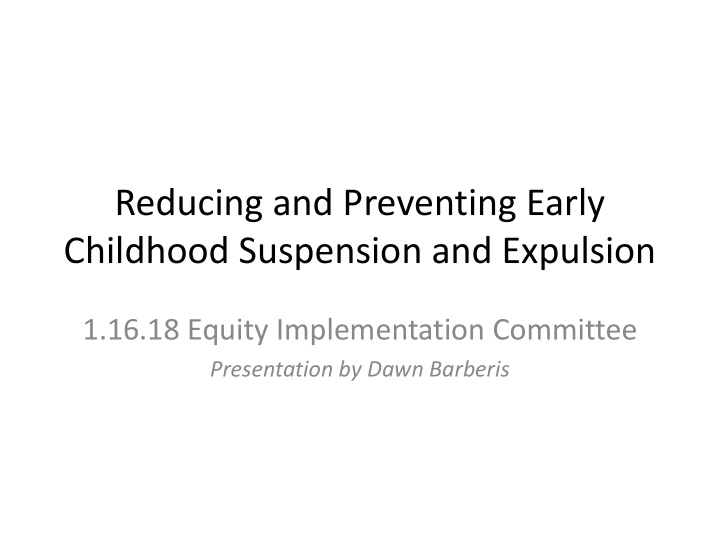



Reducing and Preventing Early Childhood Suspension and Expulsion 1.16.18 Equity Implementation Committee Presentation by Dawn Barberis
Why are doing this work? • Concerns that some ECSE children being asked to leave and/or have reduced classroom services in Head Start and other programs • National attention and new requirements re: Suspension/Expulsion in early learning • Related training needs brought to light (OHA survey)
http://preventexpulsion.org/overview/
• Four-year-olds are expelled at a rate about 50% greater than 3-year-olds. • Boys are expelled at a rate more than 4.5 times that of girls. • Black children account for less than one-fifth of all preschoolers, but almost 50% of public preschool suspensions. • Black children are also estimated to be 2 times as likely to be expelled as Latino and White children and more than 5 times as likely to be expelled as Asian- American children. http://preventexpulsion.org/overview/
Civil Rights Laws A child care provider cannot discriminate on the basis of race, religion, color, national origin, or the marital status of the child's parent(s). For more information, go to the Civil Rights Division of the Bureau of Labor and Industries website at www.oregon.gov/BOLI/CRD, or see blue pages of telephone book for local phone numbers. Americans with Disabilities Act The federal Americans with Disabilities Act (ADA) prohibit a child care provider from discriminating against any child because of a disability. A disability means "a physical or mental impairment that substantially limits one or more major life activities". Providers are required to take any actions that are not too difficult or expensive to make their homes accessible to children with disabilities. For more information on child care and ADA, go to http://www.ada.gov/childqanda.htm.
Beliefs: We believe that everyone has the ability to learn and that we have an ethical responsibility and a moral responsibility to ensure an education system that provides optimal learning environments that lead students to be prepared for their individual futures. We believe that speaking a language other than English is an asset and that our education system must celebrate and enhance this ability alongside appropriate and culturally responsive support for English as a second language. We believe students receiving special education services are an integral part of our educational responsibility and we must welcome the opportunity to be inclusive, make appropriate accommodations, and celebrate their assets. We must directly address the over-representation of children of color in special education and the under- representation in “talented and gifted.” We believe that the students who have previously been described as “at risk,” “underperforming,” “under - represented,” or minority actually represent Oregon’s best opportunity to improve overall educational outcomes ...... Education Investment Board: Equity Lens
What do we want? *Children successful in school and life *Adults who have the knowledge, skills and abilities to support all children to be successful *Robust resources and supports that can be quickly and efficiently deployed when children and adults need assistance *Collaborative, coordinated and aligned systems of support that are strengths-based
WHY DOESN’T THIS ALWAYS HAPPEN?
• Staff may feel concerned about the safety of the child or other children. • Teachers may feel overwhelmed by a child’s behavior or lack the skills to guide and respond to a child’s challenging behavior. • Work conditions, including low salaries, may contribute to teachers feeling stressed or depressed, which can affect their behavior management skills or tolerance for problem behaviors. • Classroom conditions, such as high teacher to child ratios, may affect a teacher’s ability to manage a classroom and deal effectively with children who display challenging behavior. • Teachers may misunderstand a child’s challenging behavior. A young child who has experienced trauma may engage in aggressive behaviors or use hurtful language; this behavior may be interpreted as willful or purposeful instead of a reaction to his experiences. • Implicit bias (unconscious negative beliefs) may affect teachers response to some children and can lead to more harsh consequences. • Early childhood programs may have limited resources and capacity to support staff who have difficulty with a child or family.
What have we done to date? • November 2016 – “Children Asked to Leave Placements” (CATLP) work group • January 2017 – Social-Emotional Curricula work group • February 2017 – added CCDF Suspension/ Expulsion policy to CATLP agenda • Winter-Summer 2017 – research (literature review), environmental scan, white paper and logic model • Fall 2017 – updated Social-Emotional training modules and conducted Training of Trainers • November 2017 – provided training to ELD-OCC staff • December 2017 – began presentations to stakeholders and getting input on policy and strategies
https://www.acf.hhs.gov/sites/default/files/ecd/expulhttps://www.acf.hhs.gov/sites/default/files/ecd/ex pulsion_webinar_1_basic_research_slides_21115.pdfsion_webinar_1_basic_research_slides_21115.pdf
Recommendations and Resources System Alignment and Coordination • Relevant Policies and Guidance • Data Systems Highly Skilled Workforce • Understanding and Supporting Children’s Social and Emotional Development • Professional Development Systems and Strategies • Staff Education and Certification • Other Infrastructure and Workforce Supports Early Identification of Children with Special Needs • Monitoring • Screenings • Evaluation Access to Specialized Consultation • Early Intervention/Early Childhood Special Education • Infant/Early Childhood Mental Health Consultation • Other Specialized Supports Strong Family Partnerships • Family Support Practices • Resources for Families
Recommend
More recommend